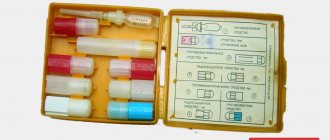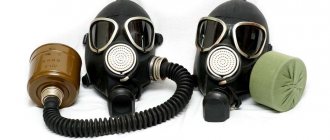Elimination of the consequences of a chemical accident
Elimination of the consequences of a chemical accident is a set of measures aimed at suppressing or reducing to the minimum possible level the impact of harmful and dangerous factors of chemical contamination that pose a threat to the life and health of people, animals and the environment.
It is organized in the interests of protecting the production personnel of the emergency facility, the population living near these facilities, protecting the environment, as well as restoring the normal functioning of the damaged production and the facility as a whole.
The main tasks solved during the liquidation of the consequences of a chemical accident are:
- detection of a chemical accident and notification of it;
- deployment of task forces to the accident area;
- identification of the chemical situation, the situation in the area of the accident;
- organization of chemical control;
- establishing and maintaining a chemical safety regime;
- providing the population, personnel of the emergency facility, participants in the liquidation of the consequences of a chemical accident with personal protective equipment;
- immediate withdrawal to a safe zone of production personnel not involved in the emergency shutdown of production, sanitary treatment of the population, personnel of the emergency facility, participants in the liquidation of the consequences of a chemical accident;
- disinfection of an emergency facility, industrial, social, residential facilities, agricultural areas, transport, other technical equipment, protective equipment, clothing, property, food and water;
- evacuation and/or resettlement of citizens from chemical contamination zones.
Elimination of the consequences of a chemical accident is carried out, as a rule, in two stages.
At the first stage:
- identification and assessment of the chemical situation;
- priority emergency work (activation of emergency systems, shutdown of the damaged area, establishment of control over the emergency installation, etc.);
- rescue work;
- providing medical care to victims;
- fire fighting;
- clearing paths for people and equipment to approach work sites.
At the second stage:
- clarification of the chemical situation;
- basic emergency work (localization and elimination of the source of chemical contamination, repair and restoration work);
- sanitary treatment of people and disinfection (neutralization) of chemical contamination.
The specific list of works and the procedure for their planning and implementation are determined by the type of accident, the technical condition of the emergency facility, and the scale of chemical contamination of the environment. The essence of the main measures to eliminate the consequences of a chemical accident is as follows. Identification of the chemical situation consists of determining, using a forecasting method or based on reconnaissance data, the scale and degree of chemical contamination of the environment. Assessment of the chemical situation includes determining the impact of chemical contamination of the environment on the behavior of personnel at an emergency facility, the population living near this facility, the actions of the RSChS forces involved in eliminating the accident and its consequences, as well as the justification of protective measures. Identification and assessment of the consequences of a chemical accident is carried out initially by the forecasting method, and subsequently by chemical and engineering reconnaissance. A prompt and reliable forecast allows you to correctly plan work to eliminate the consequences of an accident, determine the optimal amount of forces and means, and quickly carry out work to disinfect the territory of the facility and the area. Intelligence data is transmitted to the emergency response management headquarters (CoES) for generalization and analysis. Based on reconnaissance data, the consequences of the accident are assessed, and a plan for eliminating these consequences is specified. Identification and assessment of the chemical situation is organized by the forces and means of chemical reconnaissance, during which the boundaries of the source of chemical contamination of hazardous substances, the direction of cloud spread, zones of contamination, places of accumulation and stagnation of hazardous hazardous substances, the persistence and amount of released substances are determined. In addition to the above, when conducting reconnaissance, the following are determined:
- the degree of contamination of equipment, buildings and structures, equipment, air, soil, vegetation and water supply sources;
- the possibility of safe stay of production personnel and the population in the accident area, as well as the possibility of using protective equipment;
- the presence of unmarked and ownerless containers with hazardous substances, their contents, as well as the contents of spilled hazardous substances.
During chemical reconnaissance, changes in the chemical situation are constantly monitored; the time factor has a special place in chemical reconnaissance. The faster and more reliable the first results on the chemical situation and its impact on the environment surrounding the accident site are obtained, the faster a decision will be made to localize the source of the accident, the actions of the forces and their material support, and the elimination of the consequences of the accident. Chemical reconnaissance and control are carried out from the beginning of an accident at a facility until its complete elimination. Upon completion of all major work related to the elimination of the consequences of the accident at the chemical waste facility, chemical control over the accident areas is transferred to local sanitary and epidemiological authorities. The establishment and maintenance of a chemical safety regime is carried out in order to maximize the achievable and justifiable reduction in the impact of hazardous chemicals on the population, personnel of the emergency facility and participants in the liquidation of the consequences of a chemical accident. This mode is provided:
- establishing a special procedure for access to the accident zone;
- expedient selection of participants in the liquidation of the consequences of a chemical accident with their mandatory medical examination and free personal insurance;
- carrying out emergency rescue and other urgent work;
- implementation of chemical control in the contaminated zone and at the exit to the “clean” zone;
- provision of special clothing, personal protective equipment and medical care;
- carrying out disinfection work.
Emergency rescue and other urgent work (ASDNR) in the centers of chemical damage are planned and carried out in order to reduce the impact of damaging factors on the personnel of the emergency facility and the population, as well as to create conditions for restoring the operability of the facility affected by the accident. Issues of preparing and maintaining ASDNR are reflected in action plans for the prevention and liquidation of emergency situations (action plans for the prevention of chemical accidents and liquidation of their consequences). Emergency rescue operations include:
- reconnaissance of the lesion;
- localization and disinfection of hazardous chemical spills;
- localization and extinguishing of fires;
- search and extraction of victims from rubble, buried and closed spaces;
- providing first aid to the injured and evacuating them to medical institutions;
- withdrawal (removal) of facility personnel and the population from chemical contamination zones to safe areas.
Urgent work includes work to comprehensively provide emergency rescue operations, provide medical and other types of assistance to production personnel and the population affected by a chemical accident, create conditions that are minimally necessary to preserve the life and health of people, and maintain their performance. ASDNR in areas of possible chemical damage are planned in advance during the daily operation of the enterprise. The most important requirements for carrying out such operations are reliable security and high professional training of rescuers.
Sanitary treatment of people, disinfection of clothing, shoes, personal protective equipment. When carrying out work to eliminate the consequences of a chemical accident, being in a zone of chemical contamination, personnel of formations (units) involved in eliminating the accident and its consequences, facility personnel and the population may become infected with hazardous chemicals in both droplet-liquid and vapor states. In order to prevent damage to the personnel of formations (units), personnel and the population exposed to hazardous chemicals, if material resources and time are available, their partial or complete sanitary treatment is organized and carried out. Partial sanitary treatment is carried out by order of commanders of formations (units), heads of workshops (shifts), heads of management bodies of the Civil Defense and Emergency Situations or independently in the immediate vicinity of the work sites, as well as after leaving the zone of chemical contamination. With partial sanitization, exposed areas of the body, clothing and shoes that have been infected are treated (washed, wiped). Partial disinfection of clothing, shoes and personal protective equipment is carried out by everyone independently or in the form of mutual assistance by removing visible drops of hazardous substances with a rag and abundantly wetting the contaminated areas with neutralizing solutions and water. Complete sanitary treatment of facility personnel, the population and personnel of formations (units) involved in the elimination of a chemical accident and its consequences, and complete disinfection of their clothing, shoes and personal protective equipment is carried out, as a rule, in case of contamination with liquid hazardous substances that have a high boiling point. They are carried out by order of the head of the work to eliminate the consequences of a chemical accident, commanders of formations (units) and representatives of the civil defense authorities at a sanitary processing point deployed by special processing units of civil defense troops, the Russian Ministry of Defense, which have disinfection and shower installations, or at sanitary washing points ( SOP) and clothing disinfection stations (CDS) deployed at enterprises and institutions in populated areas. Complete sanitary treatment of people is carried out by washing the entire body with soap and water, with a mandatory change of linen, and, if necessary, clothing.
Localization and disinfection of the source of chemical contamination (spilled on the underlying surface of hazardous substances) is carried out with the aim of completely stopping or maximizing the rate of evaporation of spilled hazardous substances, as a result of which the source of chemical damage is completely eliminated, or its size can be significantly reduced. Localization and disinfection of sources of chemical contamination (taking into account possible types of chemical conditions during accidents at chemically hazardous facilities) may include the following basic operations: suppression of the vapor phase of primary and secondary clouds of hazardous chemicals; localization and disinfection (neutralization) of hazardous chemical spills.
The main methods of localization and disinfection of sources of chemical contamination are:
- when suppressing clouds of hazardous substances - setting up liquid curtains capable of absorbing vapors of hazardous substances with their subsequent deposition on the underlying surface;
- when disinfecting clouds of hazardous chemicals, install liquid curtains using neutralizing solutions capable of converting hazardous chemical vapors into a non-toxic chemical compound as a result of chemical interaction;
- when localizing a spill of hazardous chemicals - diking the spill, collecting the liquid phase of hazardous chemicals into pits - traps, railway tanks, emergency tanks, etc., backfilling the spilled hazardous chemicals with bulk sorbents, reducing the evaporation rate by covering the spill surface with a polymer film, foam, diluting the spill with water, introducing in spill thickeners;
- when disinfecting a spill of hazardous chemicals - filling with a neutralizing solution, diluting with water followed by the introduction of disinfectants, filling with bulk neutralizing substances, filling with solid sorbents, as well as thickening with subsequent removal and combustion in special equipment (reactors, ovens, etc.).
Equipment, transport, tools, etc., exposed to chemical contamination during the liquidation of the consequences of a chemical accident, especially associated with the release of high-boiling hazardous chemicals, are subject to special treatment. Special processing of equipment and vehicles can be carried out both at Special Processing Points (STP) deployed on the basis of special military equipment, and at the washing departments of garages of enterprises and populated areas. Processing of equipment and vehicles is carried out using the following methods:
- wiping with brushes with a disinfecting solution;
- by rinsing it off with a disinfectant solution or water.
Special treatment of the surfaces of buildings and structures is carried out with disinfecting solutions supplied using special machines such as PM, ARS and fire engines (using special devices for crushing the jet). In these cases, horizontal surfaces are treated by wiping the contaminated surfaces with brushes.
Spilled or scattered hazardous substances in the liquid or solid phase during an accident, as well as the products of their disinfection, which are in concentrations capable of causing poisoning, chemical burns, diseases and death of people, animals and plants, are subject to collection, transportation and destruction. The destruction of hazardous chemicals is carried out by order (by order) of the head of the work to eliminate the consequences of a chemical accident. The collection of hazardous chemicals in the liquid phase is usually carried out in specialized sealed containers (railway tanks, barrels, containers). In the absence of containers or a significant distance from the railway tracks, the collection of hazardous chemicals, if this does not lead to failure of technical means, can be carried out in road tanks and transported in them to places where they are discharged into specialized containers or to places where they are disinfected. The collection of hazardous chemicals in the solid phase and their transportation are carried out in specialized containers (barrels, containers) or in special containers, which are sealed (closed, welded) during storage and transportation. Sorbents used to absorb the liquid phase of hazardous substances that pose a danger to people and the environment, as well as the top layer of soil to the depth of absorption of hazardous substances, must be collected and removed from the disinfection site. They are collected in special containers (collection containers). These containers are filled to 2/3 of the volume, followed by the addition of a disinfectant to the full volume of the container. Transportation of hazardous substances in the liquid and solid phase by various types of transport is organized and carried out in accordance with the requirements of the rules and instructions for the transportation of hazardous substances.
Sources: GOST R 22.8.05-99: Emergency rescue operations during liquidation of the consequences of accidents at chemically hazardous facilities. General requirements; Methodological recommendations for eliminating the consequences of radiation and chemical accidents. Under the general editorship of Vladimirov V.A. –M., 2005; Special treatment in emergencies // Physico-chemical foundations of special treatment and liquidation of the consequences of chemical accidents: Textbook, part 2. Makarov V.A., Artemenko G.V., Koltsov G.I. –Novogorsk, 2000; Manual on the organization and technology of conducting emergency rescue and other urgent work in case of major accidents at chemically hazardous facilities. –M., 1999.









